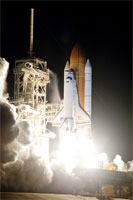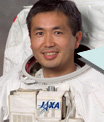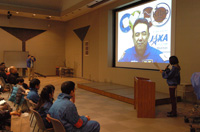Activities of JAXA Astronauts during the STS-131 Mission

Discovery's predawn liftoff: Aboard Discovery are Astronaut Yamazaki and her six crew mates (Photo Credit: NASA)
During the STS-131 mission, on which JAXA Astronaut Yamazaki flew as a crew member, other JAXA astronauts supported the mission in many different ways.
Astronaut Wakata held media briefings at NASA's Johnson Space Center (JSC) for Japanese news media to outline Yamazaki's main tasks during the mission. He provided information on the robotic arm operations Yamazaki performed aboard the ISS, referring to the significance of berthing the Leonardo Multi-Purpose Logistics Module (MPLM) to the ISS, which was one of the major objectives of Discovery's logistics mission. He also talked about Yamazaki's other tasks, elaborating on joint tasks that Yamazaki and Astronaut Noguchi performed in tandem while Discovery was docked at the ISS.
During the STS-131 mission's spacewalks, the crew members successfully replaced the Ammonia Tank Assembly (ATA) on the station's S1 truss. However, after replacing the old ATA with a new one, a valve of the Nitrogen Tank Assembly (NTA), which is used to pressurize the ATA, did not open as expected. To fix this unexpected glitch, ground teams and mission planners at the MCC-H had to consider and evaluate the possibility of adding a fourth spacewalk (EVA#4) to replace the NTA. While a draft of this unscheduled EVA was being prepared, Astronaut Furukawa took part in verifications of NTA replacement techniques/procedures, which were conducted using the pool at the Neutral Buoyancy Laboratory (NBL) at JSC, along with NASA Astronaut Michael Fossum, a spacewalk veteran who experienced performing NTA replacement during his previous mission. At the NBL, Furukawa and Fossum tested some procedures and gave their comments and opinions from the position of EVA crew for spacewalk planners to prepare the most efficient procedure for the possible NTA replacement.

Astronaut Hoshide, a CAPCOM for the STS-131 mission, at his console in the MCC-H during the STS-131 mission (Photo Credit: JAXA/NASA)
JAXA Astronaut Hoshide served as a CAPCOM (Capsule Communicator) for the STS-131 mission. Throughout the mission, he supported Yamazaki's in-flight activities and those of the other STS-131 crew members from the Mission Control Center-Houston (MCC-H) as a flight controller.
 |
"JAXA astronauts played important roles during the STS-131 mission both on orbit and on the ground. On orbit, Yamazaki operated both the shuttle's and the station's robotic arms to support the mission's primary objectives, and orchestrated cargo transfer activities between the space shuttle and the ISS as the loadmaster of the mission. Noguchi, as an ISS Expedition crew member, helped with ISS assembly operations and the cargo transfer. On the ground, Hoshide worked as a shuttle CAPCOM at the MCC-H and Furukawa participated in development of an unscheduled spacewalk procedure. Every JAXA astronaut contributed to the mission's success, and many people have witnessed the Japanese astronauts' outstanding performances. I believe that this mission visibly demonstrated the Japanese astronaut's active involvement in the ISS Program." |


